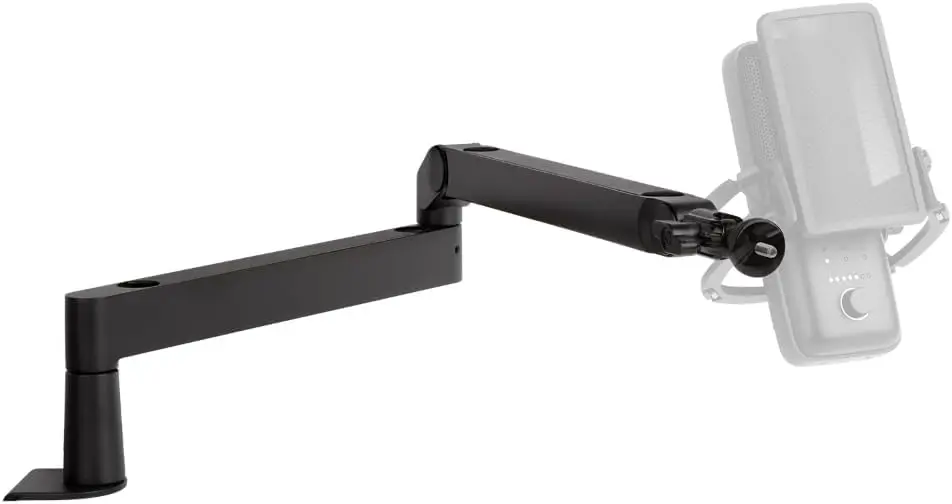Microphone arm review - The best microphone boom arms for you - for USB or XLR microphones

-
 by
Fabian
by
Fabian
- last edited: 07.11.2025
Now that you have chosen a microphone, you need either a table stand or, even better, a microphone arm. We’ll show you what you need to consider when buying one here!
TL;DR: Our recommendations
- Use our affiliate links and support our work.
Our website is free of advertising banners and we state transparently when we have been sent a product. By purchasing from our affiliate partners you do not pay more and support us. Thank you!
This could be interesting for you:

How to find the best podcast mic for you
High Profile microphone arms in comparison
Johann has the Tonor microphone boom himself and has been using it with his Shure SM7B for years. It is really inexpensive and comparatively good for the price if you pay attention to a few points: If you have a rather heavy microphone or one whose weight distribution is not centered, this microphone boom is not for you. It will be unstable and the mic could hang crookedly from the holder. Another plus point: there’s a pop guard on top.
There’s another microphone arm with table mount from Fifine. This one has a little bit more clean design, because you can run the cables mostly inside. It also feels more robust than the Tonor Version and (in our opinion) looks a bit more stylish. A good budget alternative to the T20.
This model blows up the charts. Both the cheaper model and its successor, the PSA-1+, are always number 1 in the microphone arm charts. And rightly so. Difference between the normal and the plus model: The two models have different weight specifications. The PSA-1+* can hold microphones weighing between 94g and 1.2kg, the PSA-1* from 700g to 1.1kg.
The PSA1 models can be recommended as they are good value for money. It is easy to adjust and still holds when you screw it tight.
This model is also very popular because the price-performance ratio is just right. The stand has the option of hiding the cable and running it behind a cover. This creates a tidy look for your setup. The quality of the screws and hinges is also high here. And if you want to buy an Elgato Wave:3, it’s available as part of the Wave Ecosystem bundle, including pop protection.
Nevertheless, the Elgato model is of course compatible with all common microphones.
Another premium version is the K&M model. K&M stands for high-quality microphone stands, and they have also come up with something for their microphone arm: the cable has been permanently installed in the arm for some time now. So you have a solution in which the cable management is already solved at the time of purchase. “Plug and play”, so to speak. However, the model is only available with an XLR cable.
YellowTec stands for the rather high-priced variant of microphone arms, but you can be sure of the quality here. There are also models with an integrated USB-C or XLR cable. Most Mika microphone arms also have a record light, which lights up red as soon as you start a recording. Stylish for streamers or other on-air formats! However, the price is not comparable with a Tonor model.
With the code soundandgo* you get 10% off your order in the Yellowtec Store.
Low Profile microphone arms in comparison
A low profile microphone arm can be worthwhile for streamers, content creators and video podcasters, as this arm does not hang in the whole picture, but holds the microphone to the mouth from below.
As mentioned above, this is not the most robust arm, but it is an affordable entry-level model in the low-profile range.
This microphone arm is also a modified low profile version. Here, too, you have all the options of the High Profile model above, as well as connection options and a clean workplace. Perfect for gamers or streamers, who hate unmanaged cables.
Note: Of course there are other brands that offer adjustable high and low profile microphone arms, but we don’t want to go beyond the scope of this blog article.
By the way: threaded connections or screw adapters are included with almost all models. All arms also have mounting options for a pop shield.
Microphone arm, table stand or microphone stand: which product is right for you?

A microphone boom is an arm that is usually clamped to a table. Most arms are made of aluminum and can be rotated 360°. They are also almost always compatible with the two different types of thread or come with an adapter. So you don’t need to worry about that. The table clamp, springs, screws and design are decisive when buying. A microphone boom should be flexible so that it can be moved frequently and still be rigid to hold it in place. This is why springs and screws are used. This is where the qualitative difference between the models lies! So make sure you don’t buy the cheapest model for €10, as you may only be able to adjust it a few times.
A table stand is a stand that you place on the table. Some USB microphones already come with a table stand, such as the Røde NT-USB. However, these are usually not as flexible to use as microphone arms. They are often not height-adjustable and do not have a joint that allows you to turn it in any direction.
A microphone stand usually reaches down to the floor and is used for vocal recordings in the studio.
Professional microphone arm: USB or XLR cable integrated?
The age of USB microphones has long since dawned, so your microphone holder should also adapt to this era. There are microphone arms in which you can hide the cables, but there are also models in which cables are already integrated. To remain timeless, you can certainly use an XLR cable to connect a podcast microphone, for example. The XLR connection will probably remain the audio standard for a very long time. However, if you are using a USB microphone and can therefore manage without an audio interface, you should minimize your setup.
Conclusion: The best rotating microphone arm for podcasters, streamers and gamers
Is the one that suits you. We can recommend the Røde PSA-1+* as a high profile variant, as it is affordable and really stable, looks professional and actually lasts a long time. It is not for nothing that it is constantly number 1 in sales in this category.
As a low-profile version, we recommend the Elgato Wave Mic Arm*, which is also inexpensive but of high quality and robust. The cables can also be concealed here.
Ultimately, the models are very similar and all deliver what they promise. However, it is usually the screws, springs and rubbers that determine whether the microphone boom can be used for a long time and adjusted frequently. This is where the mid-range to expensive models definitely score points.
Are you planning to podcast and don’t have a microphone yet? Check out our blog article about podcast microphones.
Links marked with * are affiliate links. There are no additional costs for you, some of these links are with an automatic discount for you. We mark these links for transparency and would never recommend bad products! You can find out more on the Our partners page.












